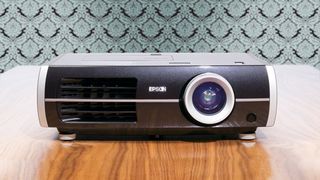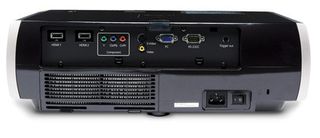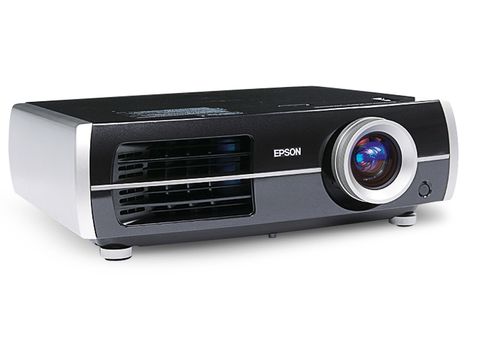TechRadar Verdict
With excellent performance all-round, this projector deserves your full attention
Pros
- +
Great picture
- +
Flexible lens system
- +
Extensive user parameters
Cons
- -
Noisy auto iris
Why you can trust TechRadar
Earlier this year, Epson's EHTW3800 scooped our Best Projector award in the under £3,000 category, and now comes its bigger brother, the formidable EH-TW5800. So has the PJ jungle got a new king?
First impressions are certainly good. This is a Full HD 1920 x 1080 flagship endowed with the brand's latest technology.
It features flavour-of-the-month D7 panels, which sport a new high-temperature polysilicon TFT liquid crystal that boosts aperture ratios by 20 per cent over last season's models. This improves luminance while using the same lamp. In the case of the TW5800, the claimed brightness is 1600 ANSI Lumens.
When it comes to picture processing, the PJ ropes in an HQV Reon VX chipset with 12bit drivers to increase colour accuracy and gradation.
The previous model's 10bit driver was capable of controlling 1.1 billion colours; the 12bit doo-hicky can control 64 times that number – 68.7 billion, in fact, which should be just about enough for anyone. The new panel also quadruples the theoretical colour gradation levels from 1,024 to 4,096.

GO LONG: This Epson can throw an image between 30 and 300 inches
The EH-TW5800 has a claimed dynamic contrast ratio of 75,000:1, resulting from a combination of a new E-TORL (Epson Twin Optimised Reflection Lamp), the D7 panels, and DeepBlack technology which prevents unwanted light from leaking through the LCDs. This is a huge improvement on the 18,000:1 contrast ratio claimed by the EH-TW3800, and we thought that was pretty good.
The full range of user adjustment parameters includes an ISF mode, so professional calibration can be achieved, and installation is aided by a flexible lens arrangement, which features optical zoom of 2.1x, vertical/horizontal adjustment of +/- 96 per cent and +/- 47 per cent. A third-party anamorphic lens can also be added for 2.35:1 projection without black bars or loss of resolution.
Hide the wires
Looks-wise, the 5800 is glossy and business-like; its boxy exterior has no real distinguishing features except the off-centre lens. Thoughtfully, though, a cable cover is provided so you can conceal the spaghetti once everything is plugged in.
Connections include twin HDMI v1.3a sockets, a D-Sub for PC input, an RS-232C controller and one 12V trigger to synchronise the projector up with a motorised screen.

HOOK ME UP: The Epson EH-TW58000's twin HDMI inputs and component jack should cover most usage
I found installation a doddle, thanks to the flexible lens. Its focal length of 22.5-47.2mm gives screen sizes of between 30in and 300ins, typically 100in at a range of 2.98-6.36m, depending on the zoom setting.
Plug in and fire up with a Blu-ray source connected via HDMI, and the projector defaults to 'HD' picture preset, yet I was more impressed with the Silver Screen preset, which gives a close to ideal colour temperature of 6,493k. It should be your viewing preset of choice out-of-the-box.
Vivid Mode is for use in bright rooms (yes, I know that sounds an odd thing to say about a projector) and is painfully unwatchable in the dark – but it does emphasise how capable this projector's 200W lamp is when it really has to compete with daylight.
The Cinema Filter system offers numerous further modes to select depending on the source material, ambient lighting conditions and type of screen being used.
The x.v.Colour mode expands the colour gamut to 115 per cent of normal, not of any real use unless you have compatible source material.
In normal operation the projector is fairly quiet, measuring around 22dB, but if you switch on the auto iris, the noise of the iris opening and closing is quite audible over quiet dialogue. So much so that I tried to avoid using it. Improving this should clearly be an imperative for Epson's development engineers.
Monkey magic
I subjected the Epson to my usual selection of test discs, starting with Second Sight's sublime Blu-ray release of Baraka.
I noted immense amounts of detail in the tribal costumes and monkey fur, extremely bright and stable colours, and a sharpness and depth, which was immediately impressive. The Epson's frame interpolation feature, designed to suppress blurring between frames and deliver a more film-like image, does a good job of limiting smearing.
A DTS demo disc with a Behind Enemy Lines sequence that has been known to come across as a blurry mess with other projectors – the literal 'fog of war' – was here delivered with a confidence and solidity.
Needless to say, as a 3 x LCD design, the Epson is immune to the rainbow effects, which plague DLP projectors; but neither did it suffer from the chicken wire nonsense of yesteryear's LCDs, delivering a solid-looking image with no suspicion of mesh.
Image-wise the TW5800 is gorgeous. Colour fidelity is rich and details and texture ping off the screen. Doubtless this is due to the combination of the D7 panel, HQV processor and Epson's DeepBlack system.
In terms of picture delivery, I'd rate it as comparable to some of the other big hitters already out. The Sanyo PLV-Z3000, for instance, has the D7 panel, as does the Panasonic PT-AE3000; the Epson's 1,600 Lumen brightness is equal to that of the Panasonic, too, although the Sanyo can only claim 1,200.
However, the Epson has a more rounded specification, which gives it the edge. Industry veteran Robert Sinden, now the distributor of high-end AV kit from Steinway Lyngdorf, favours this very Epson over more expensive projectors, recently telling us: "I've compared it with ultra-high end models costing many times more and it blows them out of the water." It's difficult to disagree.
Don't ignore it!
Commercially, the excellence of its cheaper sibling, the EH-TW3800, may deprive this model of some attention; but that would be a pity, as it's an impressive example of bleeding-edge LCD projection that demands to be auditioned.
Follow TechRadar Reviews on Twitter: http://twitter.com/techradarreview

